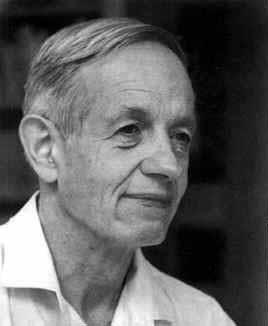| Profile | Major Works | Resources |
John F. Nash, 1928-2015

When the 21-year old John Forbes Nash, Jr wrote his 27-page dissertation outlining his "Nash
Equilibrium" for strategic non-cooperative games, the impact was enormous. On the
formal side, his existence proof was one of the first applications of Kakutani's
fixed-point theorem later employed with so much gusto by Neo-Walrasians
everywhere; on the conceptual side, he spawned much of the literature on non-cooperative
game theory which has since grown at a prodigious rate - threatening, some claim, to
overwhelm much of economics itself.
When the young Nash had applied to graduate school at Princeton in 1948, his old Carnegie Tech professor, R.J. Duffin, wrote only one line on his letter of recommendation: "This man is a genius". It was at Princeton that Nash encountered the theory of games, then recently launched by John von Neumann and Oskar Morgenstern. However, they had only managed to solve non-cooperative games in the case of "pure rivalries" (i.e. zero-sum). The young Nash turned to rivalries with mutual gain. His trick was the use of best-response functions and a recent theorem that had just emerged - Kakutani's fixed point-theorem. His main result, the "Nash Equilibrium", was published in 1950 in the Proceedings of the National Academy of Sciences. He followed this up with a paper which introduced yet another solution concept - this time for two-person cooperative games - the "Nash Bargaining Solution" (NBS) in 1950. A 1951 paper attached his name to yet another side of economics - this time, the "Nash Programme", reflecting his methodological call for the reduction of all cooperative games into a non-cooperative framework.
His contributions to mathematics were no less remarkable. As an undergraduate, he had inadvertently (and independently) proved Brouwer's fixed point theorem. Later on, he went on to break one of Riemann's most perplexing mathematical conundrums. From then on, Nash provided breakthrough after breakthrough in mathematics.
In 1958, on the threshold of his career, Nash got struck by paranoid schizophrenia. He lost his job at M.I.T. in 1959 (he had been tenured there in 1958 - at the age of 29) and was virtually incapicated by the disease for the next two decades or so. He roamed about Europe and America, finally, returning to Princeton where he became a sad, ghostly character on the campus - "the Phantom of Fine Hall" as Rebecca Goldstein described him in her novel, Mind-Body Problem.
The disease began to evaporate in the early 1970s and Nash began to gradually to return to his work in mathematics. However, Nash himself associated his madness with his living on an "ultralogical" plane, "breathing air too rare" for most mortals, and if being "cured" meant he could no longer do any original work at that level, then, Nash argued, a remission might not be worthwhile in the end. As John Dryden once put it:
Great wits are sure to madness near allied,
And thin partitions do their bounds divide.(John Dryden, Absalom and Achitophel, 1681)
Nash shared the Nobel prize in 1994 with John C. Harsanyi and Reinhard Selten - for what he claims was his "most trivial work"!
|
Major Works of John F. Nash
|
|
HET
|
|
Resources on John Nash
|
All rights reserved, Gonšalo L. Fonseca
